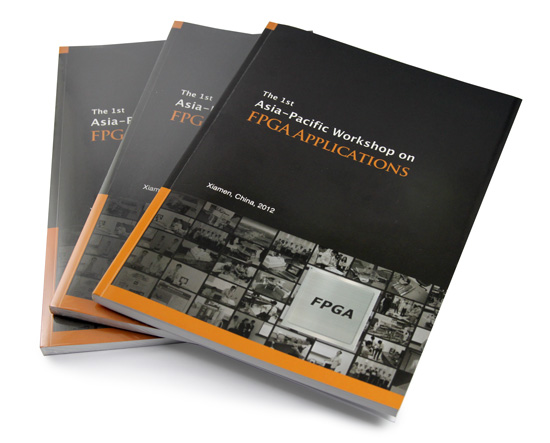![]()
작성일: 2015.10.12

Overview
Field Programmable Gate Array (FPGA) devices have become more and more prevalent in today’s electronic design in various fields, such as telecommunications, networking, automotive, and military. Having once been seen as only required in “high-end” laboratory settings, over the years, FPGAs have quickly penetrated the sphere of mid-range and even low-end design needs as device costs have decreased. As a “programmable” device, the FPGA is capable of being altered into different forms of digital circuitry at the touch of a button - all within a single chip. Limited in only the amount of logic resources provided, the FPGA has increasingly obtained prominence through giving researchers and engineers the ability to quickly prototype different designs in critically faster periods than that of a traditional integrated circuit design approach.
The Asia-Pacific Workshop on FPGA Applications publication brings together top talents in the field of FPGA design. Of the 15 papers featured in this collection, 5 are from top researchers based in China, with a contributing article from international researcher Yin Chang. Also included in this collection are award-winning projects from the 2012 InnovateAsia Design Competition. By promoting excellence in the programmable logic design, this workshop aims to further the knowledge and expertise through international awareness and mutual collaboration of the world's best engineering scholars in academia and industry.
Introduction
About the Workshop
Welcome to the 1st Asia-Pacific Workshop on FPGA Applications! By gathering the brightest international minds in FPGA practice and implementation, this workshop aims to foster creativity and brilliance by promoting research dedicated to the development and advancement of FPGA-based technologies. The Asia-Pacific Workshop covers the entire Asia region and is open to all researchers, engineers, and students. Included in this edition are top five researchers based in China, with many other fantastic works from the annual InnovateAsia Design Competition.
This year’s workshop includes papers that truly demonstrate the power and progress of FPGA technology. With the first generations of FPGAs featuring around nine thousand gates, we’re already in the era of millions and tens of millions of gates while speedily approaching the newest 20nm node processes. As programmable devices get cheaper, faster, and better, researchers and engineers are finding that developing on FPGAs is becoming the most viable design strategy. Traditional approaches of integrated circuit development typically require vast amounts of resources and development while posing great risk in the event of a design flaw. ASIC development is also prone to obsolescence, as newer communication and technological standards are continuously adopted by the industries. FPGAs provide an apt solution by enabling engineers to quickly prototype and debug designs before shipping to market. Due to the many advantages, FPGAs have already transcended their role of high-end, high-cost design components, penetrating into virtually every vertical of every industry. Unsurprisingly, FPGAs are expected to become the go-to design solutions in the near future.
Thus, it’s with boundless excitement we bring you the first ever workshop and publication of this nature to the FPGA scene. Through mutual collaboration and relentless energy, we aim to truly become a significant factor in the expansion and improvement in the world of programmable logic design.
About InnovateAsia Design Contest
The Innovate Design contest is a multi-discipline engineering design contest hosted across the world and open to all graduate and undergraduate engineering students. InnovateAsia 2012 was witness to nearly a thousand teams from hundreds of different institutions all over China and Taiwan, including top universities such as Tsinghua University, National Taiwan University, all competing for the top prize. Engineering students toil through months of effort, spending countless sleepless nights in the laboratory to bring forth their impressive creations to expert judges and scientists through multiple stages of qualification and evaluation. Having already experienced immense success, InnovateAsia is cited by students as one of the most critical stepping-stones in their advancement towards learning digital logic design, discipline, and overall understanding of the industry. For more information, please visit http://www.innovateasia.com for more details.
Contents
Contributing Author
- Applying Research Outcomes into Innovation and Technology for Better Health Care and Life Quality
Yin Chang
Research Pages
- Implementing Full HD Video Splitting on Terasic DE3 FPGA Platform
Rosaline Lin - Design of Large-scale Wire-speed Multicast Switching Fabric Based on Distributive Lattice
CUI Kai, LI Ke-dan, CHEN Fu-xing, ZHU Zhi-pu, ZHU Yue-sheng - FPGA Implementation of an Efficient Two-dimensional Wavelet Decomposing Algorithm
Chuanyu Zhang, Chunling Yang, Zhenpeng Zuo - FPGA Implementation of a Multi-Core System Architecture for Power Adaptive Computing
HUANG Le-tian, Fang Da - Introduction of the Research Based on FPGA at NICS
Rong Luo - SOPC-based VLF/LF Three-dimensional Lightning Positioning System
Xiao Zhou, Sheng Chang, Qijun Huang, Qiming Ma, Gaochao Gong - 3D Position Tracking of Instruments in Laparoscopic Surgery Training
Shih-Fan Yang, Ming-Feng Shiu, Bo-Kai Shiu, Yuan-Hsiang Lin - Air Guitar on Altera DE2-70 FPGA Architecture
Ger Yang, Tzu-Ping Sung, Wei-Tze Tsai, advised by Shao-Yi Chien - Autostereoscopy Image Display System
Du Lei, Tang Wenlong, Ye Peng, Liu Hailong - Design and Development of 3D Motion Sensing Gaming Platform using FPGA
Liu Xinming, Wang Chongsen, Wang Zhiheng - Development of EEG-based Intelligent Wheelchair Based on FPGA
Huang Xueye, Wan An, Chen Zhijie - Electric Unicycle from Image Signals
Yuan-Pao Hsu, Sheng-Han Huang, Chien-Hung Kuo, Hung-Chih Chen - Holographic Display System Based on FPGA and DLP Technology
Hai Jiao, LingBo Wang, HaiXiao Wang - Implementation of a Calligraphy Mechanical Arm Based on FPGA
Chen Jiaming, Liang Lichang - Implementation of a Quad-Rotor Robot Based on SoPC
Yuan-Pao Hsu, Jie-Tong Zou, Tang-Shih Bo, Yu-Chiung Tseng, Kuang-Wei Huang, 6Chao-Heng Chiu - TDTOS – T-shirt Design and Try-On System
Chen-Yu Hsu, Chi-Hsien Yen, Wei-Chiu Ma, Shao-Yi Chien
Download
http://www.terasic.com.tw/cgi-bin/page/archive.pl?Language=English&CategoryNo=161&No=809&PartNo=5
출처: http://www.terasic.com.tw/cgi-bin/page/archive.pl?Language=English&CategoryNo=&No=809
![]()